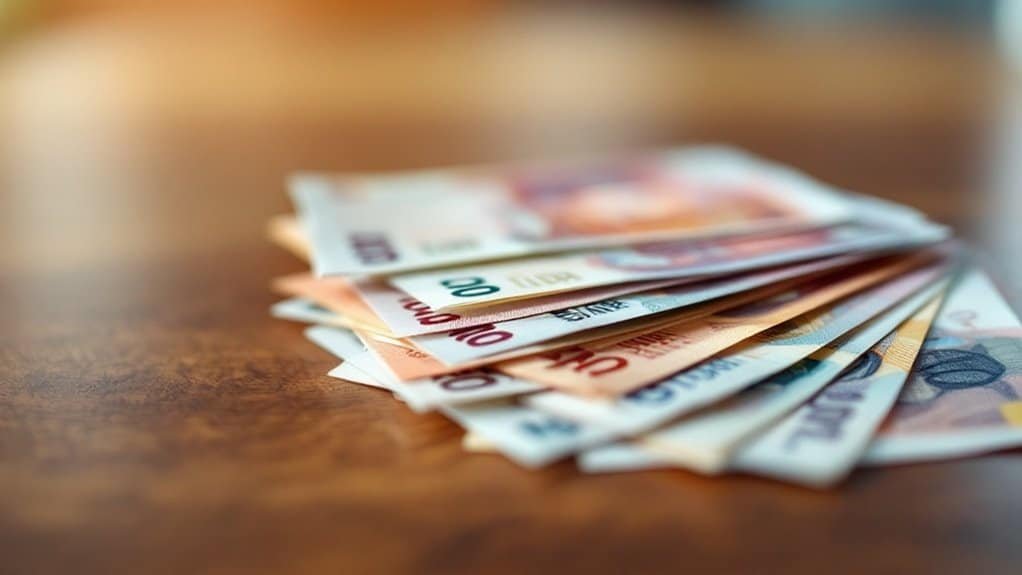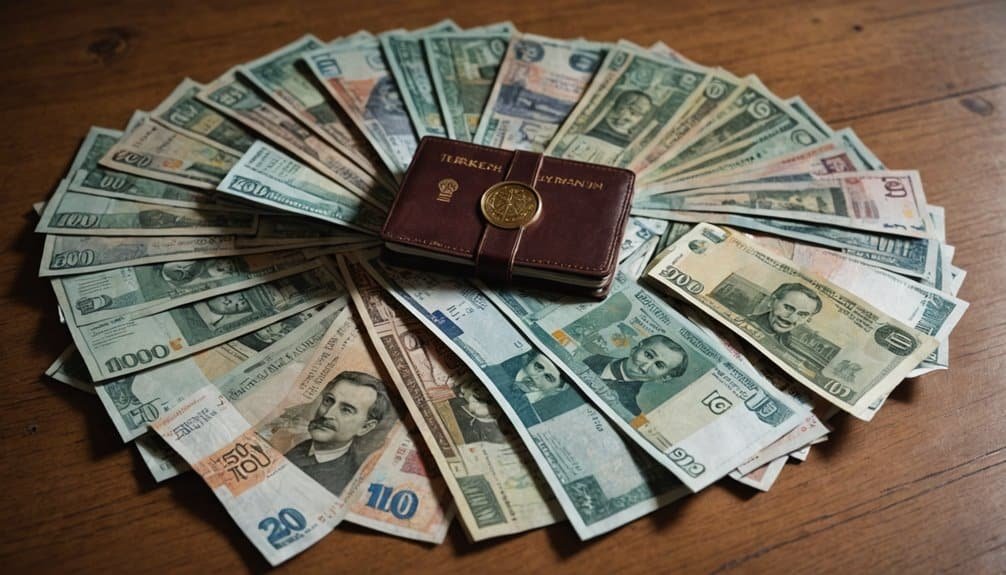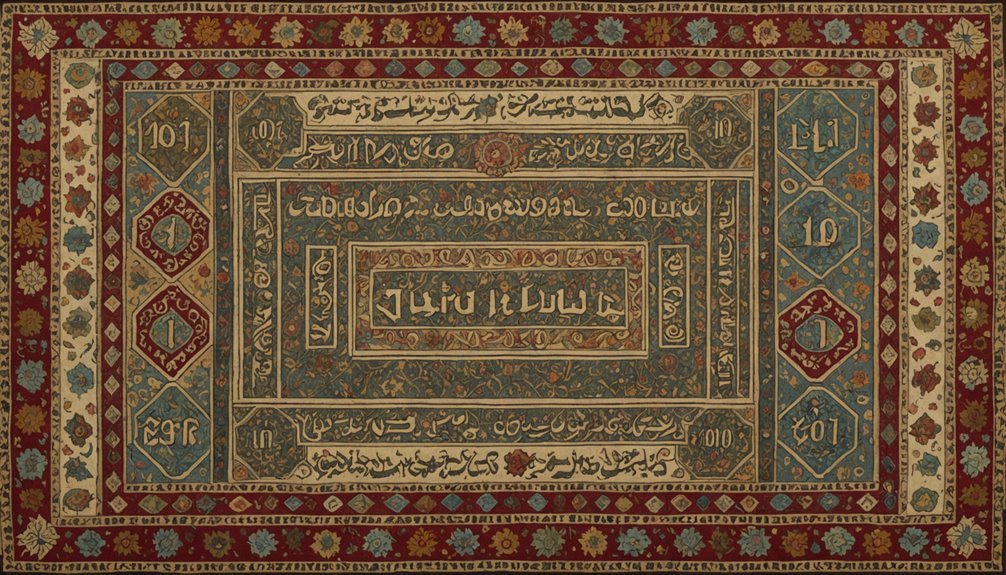
When visiting Turkey, you'll need to understand the Turkish Lira's volatile financial landscape. The currency trades at approximately 1 USD = 34.72 TRY, with inflation consistently above 47%. You'll want to prioritize cash safety, use hotel safes, and carry Turkish lira for local transactions. Digital payment methods have surged 138% year-on-year, offering convenient alternatives. Major banks' ATMs provide lower withdrawal charges, while travel tools like Wise can reduce conversion fees. West Turkish venues may accept euros, and tourist sites often take US dollars. Your financial strategy can make or break your travel experience—and there's much more to unpack about traversing Turkey's economic terrain.
Key Takeaways
- Carry Turkish Lira for local transactions, with cash recommended for small purchases at markets, street vendors, and traditional establishments.
- Expect significant currency volatility, with current exchange rates around 1 USD = 34.72 TRY and high annual inflation exceeding 47%.
- Use ATMs from major Turkish banks to minimize withdrawal fees, preferring those linked to international networks for better transaction security.
- Leverage digital payment methods, which have seen a 138% rise in card transactions, while keeping Euros and US dollars as backup currency.
- Protect your money by using hotel safes, monitoring financial transactions, and utilizing travel-friendly banking tools like Wise to reduce conversion charges.
Understanding the Turkish Currency
By January 2009, the currency reverted to its simple "Turkish Lira" designation. Currency volatility has been a significant economic characteristic of the Turkish financial system in recent years.
You'll find the currency subdivided into 100 kuruş, with banknotes ranging from 5 to 200 lira.
Each denomination features distinct security features and portraits of Mustafa Kemal Atatürk, reflecting both economic practicality and national pride.
Understanding these nuances will help you navigate Turkey's financial landscape more confidently.
Navigating Exchange and Payment Methods
Understanding the intricacies of exchange rates and payment methods is essential for travelers visiting Turkey. With the current exchange rate at 1 USD = 34.72 TRY and a 19.98% increase from last year, you'll want to stay informed about currency fluctuations.
Economic volatility has prompted Turkish financial institutions to develop more robust digital payment infrastructures to mitigate risks associated with rapid currency changes.
While euros are widely accepted in western Turkey and US dollars work in tourist attractions, relying on local currency minimizes potential monetary losses.
Digital payment methods have surged dramatically, with a 138% year-on-year increase in card transactions. Credit cards, bank cards, and prepaid cards are increasingly popular.
However, carry some Turkish lira for small transactions in cash-only venues like roadside cafes, street food stands, and the Grand Bazaar. This approach guarantees smooth financial navigation during your Turkish travels.
Money Management Travel Tips

Prioritize cash safety by utilizing hotel safes and secure wallets, minimizing exposure to potential theft.
Implement robust budgeting strategies by leveraging public transportation, seeking out local dining options away from tourist zones, and researching cost-effective attractions. Turkish Lira's fluctuating exchange rates make strategic financial planning essential for budget-conscious travelers.
Monitor your financial transactions meticulously, tracking ATM withdrawals and currency exchanges with precision.
Utilize travel-friendly banking tools like Wise to mitigate excessive conversion fees.
Opt for ATMs affiliated with major banks to reduce withdrawal charges, and always maintain a buffer for unexpected expenses.
Strategic financial planning guarantees you'll navigate Türkiye's economic landscape confidently, maximizing your travel budget while minimizing financial risks.
Economic Context and Inflation
Because Turkey's economic landscape has been dramatically reshaped by persistent inflationary pressures, travelers must grasp the nuanced dynamics of the Turkish Lira's volatility.
The nation's inflation rate has consistently exceeded 47%, creating significant currency instability that directly impacts your travel experience. With food prices surging by 68.1% annually and the Central Bank maintaining high interest rates at 50%, you'll encounter substantial price fluctuations across goods and services.
The economic context reveals profound challenges in currency stability. Rapid price increases erode purchasing power, meaning your travel budget can dramatically shrink within weeks. Foreign investor sentiment suggests ongoing economic uncertainty could further complicate travel financial planning.
International investors and local consumers alike face uncertainty, which translates to potential unpredictability in transportation, accommodation, and daily expenses. Understanding these economic dynamics is essential for financial planning during your Turkish journey.
Cultural Significance of Lira

Beyond the economic volatility that shapes Turkey's monetary landscape, the Turkish lira emerges as a profound cultural artifact that narrates the nation's complex historical journey. The currency serves as a visual chronicle of Turkey's change, embedding cultural symbols and historical figures that reflect its national identity. Currency redesigns since 2005 have systematically simplified and modernized the monetary representation, reflecting Turkey's commitment to economic clarity and progression.
Key cultural dimensions of the lira include:
- Featuring Mustafa Kemal Atatürk's image across multiple denominations
- Displaying iconic landmarks like Hagia Sophia
- Incorporating the star-and-crescent national emblem
- Representing pivotal moments in Turkish independence
The lira's design evolution mirrors political shifts, evolving from state-centric themes to more individualistic representations.
Each banknote and coin becomes a miniature canvas, communicating Turkey's rich historical narrative and contemporary aspirations through carefully curated visual elements that resonate with national pride and cultural heritage.
Conclusion
Your Turkish lira journey reveals complex economic dynamics. In 2022, the Turkish lira experienced a staggering 64.3% inflation rate, dramatically impacting currency valuation. You'll want to stay financially agile, converting currency strategically and monitoring exchange rates. Understanding these economic nuances will transform your travel experience, enabling smarter financial decisions and deeper cultural insights into Turkey's intricate monetary landscape.







Interesting read, but arent cryptocurrencies becoming more relevant for travelers than traditional currencies like the Turkish Lira?
So, anyone else think the Turkish Lira is undervalued? Just considering the rich history and vibrant culture, its gotta be worth more, right?